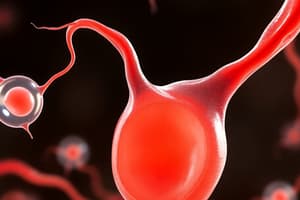Podcast
Questions and Answers
How many female germ cells are present in the ovary at birth?
How many female germ cells are present in the ovary at birth?
- Significantly lower than in the fifth month of prenatal development (correct)
- Approx. 400
- Approx. 7 million
- Approx. 2 million
During childhood, what happens to most oocytes?
During childhood, what happens to most oocytes?
- They remain dormant until puberty
- They increase in number
- They become atretic; fewer than 500 will be ovulated (correct)
- They are all ovulated
At puberty, what is the approximate total number of female germ cells in the ovary?
At puberty, what is the approximate total number of female germ cells in the ovary?
- Approx. 400 (correct)
- Approx. 500
- Approx. 7 million
- Approx. 2 million
How long does the process of spermatogenesis and spermiogenesis take?
How long does the process of spermatogenesis and spermiogenesis take?
What is the total number of female germ cells in the ovary in the fifth month of prenatal development?
What is the total number of female germ cells in the ovary in the fifth month of prenatal development?
Flashcards are hidden until you start studying
Study Notes
Female Germ Cells
- Around 1-2 million female germ cells are present in the ovary at birth.
- During childhood, most oocytes undergo atresia, a process of degeneration and resorption.
- At puberty, the approximate total number of female germ cells in the ovary is around 300,000-400,000.
Spermatogenesis
- The process of spermatogenesis and spermiogenesis takes around 64-74 days.
Prenatal Development
- In the fifth month of prenatal development, the total number of female germ cells in the ovary is around 2 million.
Studying That Suits You
Use AI to generate personalized quizzes and flashcards to suit your learning preferences.




